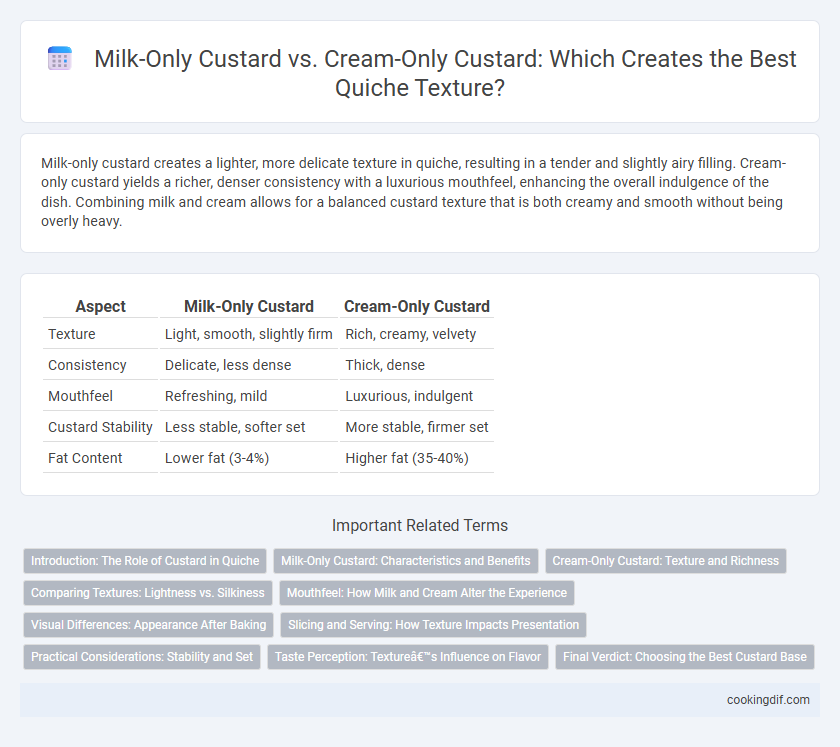Milk-only custard creates a lighter, more delicate texture in quiche, resulting in a tender and slightly airy filling. Cream-only custard yields a richer, denser consistency with a luxurious mouthfeel, enhancing the overall indulgence of the dish. Combining milk and cream allows for a balanced custard texture that is both creamy and smooth without being overly heavy.
Table of Comparison
| Aspect | Milk-Only Custard | Cream-Only Custard |
|---|---|---|
| Texture | Light, smooth, slightly firm | Rich, creamy, velvety |
| Consistency | Delicate, less dense | Thick, dense |
| Mouthfeel | Refreshing, mild | Luxurious, indulgent |
| Custard Stability | Less stable, softer set | More stable, firmer set |
| Fat Content | Lower fat (3-4%) | Higher fat (35-40%) |
Introduction: The Role of Custard in Quiche
Milk-only custard in quiche produces a lighter, silkier texture with a delicate mouthfeel, while cream-only custard results in a richer, denser consistency that enhances flavor intensity. The choice between milk and cream directly influences the smoothness and firmness of the quiche filling, where milk maintains a subtle softness and cream adds luxurious creaminess. Understanding the custard base is essential for achieving the desired balance between tender custard and structural integrity in quiche.
Milk-Only Custard: Characteristics and Benefits
Milk-only custard in quiche offers a lighter, more delicate texture compared to cream-based custards, resulting in a tender and slightly firmer filling. The lower fat content in milk enhances the clean, savory flavors of the quiche ingredients, making it ideal for balanced taste profiles. This custard variation also reduces richness without compromising moisture, appealing to those seeking a less heavy yet satisfying quiche experience.
Cream-Only Custard: Texture and Richness
Cream-only custard in quiche delivers a luxuriously rich and velvety texture due to its higher fat content compared to milk-only custard. The increased cream fat enhances the custard's silkiness and provides a more tender, melt-in-the-mouth consistency. This richness intensifies the overall flavor profile, making cream-only custard the preferred choice for indulgent quiches with a smooth, decadent bite.
Comparing Textures: Lightness vs. Silkiness
Milk-only custard in quiche creates a lighter, more delicate texture with a slightly fluffier mouthfeel, ideal for those seeking a less rich experience. Cream-only custard yields a silkier, denser consistency, providing a luxurious, velvety finish that enhances flavor depth. Balancing milk and cream adjusts the texture, allowing bakers to customize between lightness and silkiness according to preference.
Mouthfeel: How Milk and Cream Alter the Experience
Milk-only custard in quiche produces a lighter, silkier mouthfeel with a subtle creaminess that lets the filling's flavors shine more distinctly. Cream-only custard delivers a richer, denser texture that enhances the overall indulgence and adds a velvety smoothness to each bite. The fat content in cream contributes to a luscious, luxurious mouthfeel, while milk offers a more delicate, tender custard consistency.
Visual Differences: Appearance After Baking
Milk-only custard in quiche results in a lighter, more translucent filling with a delicate golden hue and a slightly set, matte surface after baking. Cream-only custard produces a richer, denser texture with a deep golden-brown color and a glossy, smooth top that signals higher fat content. The visual contrast highlights milk custard's subtle, tender finish versus cream custard's sumptuous, indulgent appearance.
Slicing and Serving: How Texture Impacts Presentation
Milk-only custard in quiche yields a lighter, more delicate texture that slices cleanly, enhancing neat presentation and ease of serving. Cream-only custard produces a richer, denser consistency, which may result in a softer slice that can be more challenging to cut without crumbling. The balance of milk and cream directly affects the custard's firmness, influencing the visual appeal and structural integrity of each serving.
Practical Considerations: Stability and Set
Milk-only custard in quiche yields a lighter texture with moderate firmness, offering easier setting due to its higher water content and lower fat, which enhances stability during baking. Cream-only custard provides a richer, denser texture with a silkier mouthfeel but may risk a softer set and potential separation because of its elevated fat content. Balancing milk and cream optimizes custard stability and firmness, improving quiche structure and preventing curdling or weeping during cooking.
Taste Perception: Texture’s Influence on Flavor
Milk-only custard in quiche yields a lighter, creamier texture that enhances subtle flavors and allows the egg's natural taste to shine through. Cream-only custard produces a richer, denser mouthfeel that intensifies buttery and savory notes, creating a more indulgent flavor experience. Texture directly influences taste perception by modulating how flavors release and linger on the palate.
Final Verdict: Choosing the Best Custard Base
Milk-only custard in quiche yields a lighter, more delicate texture with a subtle creaminess, ideal for those seeking a less rich experience. Cream-only custard delivers a dense, velvety consistency with intense richness, perfect for indulgent quiches. The best custard base depends on texture preference: milk for a tender bite and cream for a luxurious mouthfeel.
Milk-only custard vs cream-only custard for texture Infographic

 cookingdif.com
cookingdif.com